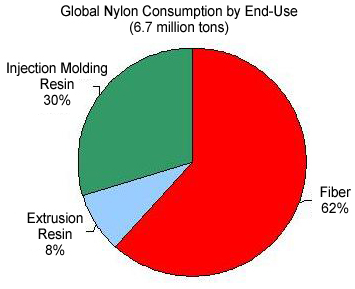
| 2007 was a good year for the polymer industry. But, the global economic recession in 2008 saw polymer demand plummeting by about 5-10%, bringing down profits to lower levels or to negative levels. Commodity polymers declined by 5-7% but ETP declined almost 10% on reduced demand from automotive and consumer electronics sector. About 45% of polyamide is used as ETP as it has metal replacement applications in automotive and other industrial sectors. This sector has been negatively impacted due to economic turndown. It is estimated that average growth rate will be only 3% instead of typical 5-6% from 2009 until 2014.
Market outlook for nylon 6 and nylon 6.6 varies extensively depending on domestic demand and current market conditions in each country as per Chemsystems. Overall, developed markets of North America and Europe will experience sluggish growth over the foreseeable future as a result of the global economic downturn and movement of several manufacturing activities into lower-cost base countries. One of Japan�s very mature markets (automotive industry) will likely suffer low growth over the next coming years due to saturated market conditions and steady erosion of the Japanese manufacturing base. China is expected to be one of the fastest growing countries for ETP nylon, largely driven by phenomenal growth in the automotive and electrical/electronics markets. Polyamides or nylons are the first engineering plastics and still represent the biggest and most important class of these types of material. Polyamides comprise a wide range of materials, depending on the monomers employed. Commonly used products are designated as nylon 6, 6.6, 6.12, 11 and 12 with the nomenclature designating the number of carbon atoms that separate the repeating amide group. Nylon 6 and nylon 6.6 continue to be the most popular types among polyamide commercial products, still accounting for more than 90% of nylon used in the global market. Polyamides are a versatile family of thermoplastics that have a broad range of properties ranging from relative flexibility to significant stiffness, strength, and toughness. Major properties such as resistance to chemicals, toughness, thermal stability, good appearance and good processability are key considerations that make nylon suitable for engineering plastics applications. Traditionally, majority of nylon produced was used in the fiber application. This consumption trend has changed substantially over the past decade with increasing proportion of nylon going into the engineering thermoplastics market. This is due to the fact that nylons have particular utility in performing mechanical duties that traditionally relied on metal parts. In terms of properties, nylon 6 and nylon 6.6 appear to be comparatively similar although nylon 6 has better toughness and processability. Though, nylon 6.6 has superior mechanical properties and higher heat resistance. For engineering plastics, both nylon 6 and nylon 6.6 can be used over an extensive range of applications including automotive, consumer, industrial, electrical and electronics segments. Overall, automotive applications have been the major driver for this positive growth in recent years in the trend towards replacing metal parts with plastics, in order to reduce weight and costs as well as meet vehicle emission standards.  |
Previous Article
Next Article
{{comment.DateTimeStampDisplay}}
{{comment.Comments}}